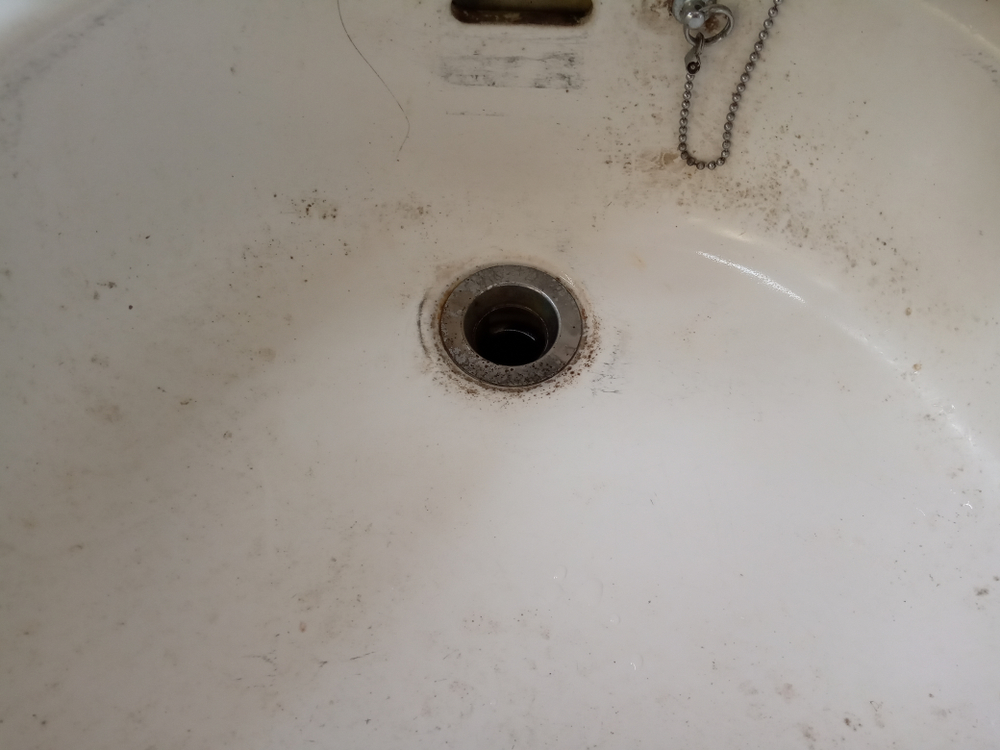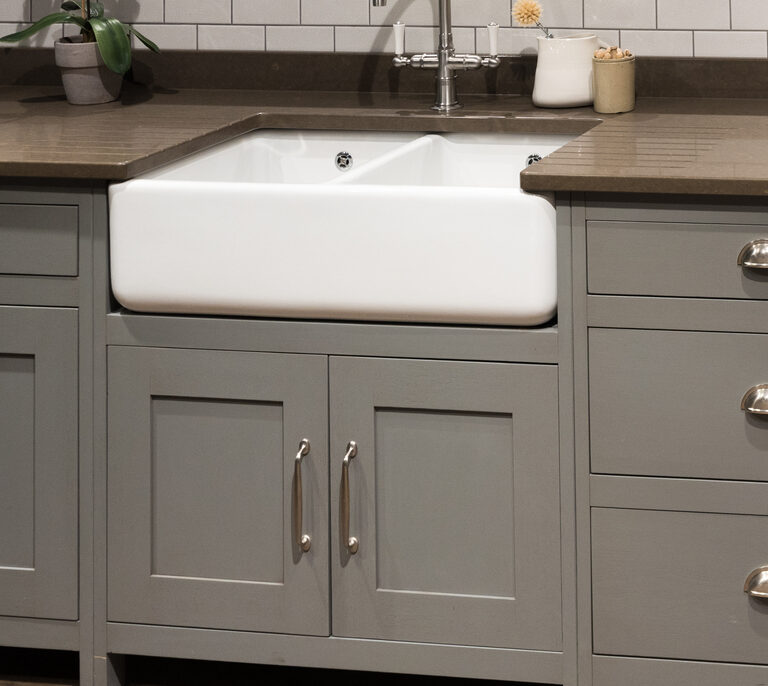Porcelain is an extremely hard and durable ceramic material that can be made in virtually any color, which makes it popular for kitchen sinks, bathroom sinks, and bathtubs. It’s also easy to clean, which only serves to make it an attractive material around the house.
Many years ago, porcelain sinks were pretty much the only type of sink, and today both vintage and new porcelain sinks are in high demand for rooms like kitchens, bathrooms, and even laundry rooms. Whether you’ve got a brand-new porcelain sink or one that’s been around for decades, there are a few things to keep in mind if you want to keep this workhorse going for many years to come.
Everyday Cleaning
Porcelain is certainly a low-maintenance material, but that doesn’t mean you can entirely overlook it in your cleaning routine. In fact, a few simple methods can help you avoid a more involved cleaning task down the road.
Regardless of where the sink is, giving it a quick daily cleaning is the best way to keep your porcelain sink looking shiny and new. If it’s a kitchen sink, use the sprayer to wash away any large food particles. Wet a regular kitchen sponge and add a dash of dish soap to create some suds, then gently wash every porcelain area of the sink, including the base sides, and any other portions of the sink that are porcelain.
Especially with a bathroom sink, cleaning the area around the faucet can be a challenge, so consider an old toothbrush with soft bristles or any all-purpose brush with soft bristles to get into crevices.
Once you’ve thoroughly washed every area of the sink, come back with the sprayer or a wet paper towel or washcloth to rinse away the soap. In addition to making sure there’s no buildup of soap, doing this lets you get a close look at the surface to see if there are any scratches, stains, or marks.
If the sink now appears pristine (or at least good enough for you), take a soft dry cloth like a kitchen towel or flour sack to dry the wet surfaces and give the sink a final buff. Unless you have stains, dark scuffs, or scratches, this will restore the luster to your porcelain sink, and it’s an easy job to do every day or every few days, depending on how often the sink is used (and for what).
Scratch & Scuff Removal
While porcelain sinks are durable, they are also prone to scuffing, scratching, and even staining. If you’ve done a basic scrubbing with a regular sponge and dish soap and you notice the sink isn’t returning to its normal color or that there are scratched areas, the fix is likely an easy one.
Often what appears to be scratches on porcelain (like a silver-colored mark in a white kitchen sink) are superficial marks or scuffs, left by, for example, a metal pot being placed in the sink. A true scratch would involve damage to the finish of the sink itself. In any event, the methods for removing marks and scuffs and minimizing the look of scratches are the same.
Your instinct when encountering scuffs or scratches while doing your regular sink cleaning may be to simply scrub harder. Depending on type of sponge you’re using, this may work to buff out many of the marks. However, be careful with how much pressure you apply, as scrubbing too hard with the abrasive side of a kitchen sponge can erode the surface of the porcelain.
Stubborn marks and discoloration may remain after your soap-and-water cleaning. There are a few options, and it may be necessary to experiment to find out what works the best for your sink. Here’s a look at the most common methods:
Bleach
This is only suitable for white porcelain sinks, and it’s not recommended for vintage or antique porcelain sinks, as they are likely to be more delicate than newer sinks. For sinks that aren’t white, this step works well with hydrogen peroxide.
Pour a bit of the bleach or hydrogen peroxide into a spray bottle; make sure you use a new one or one that’s been thoroughly cleaned and dried to avoid any chemical interactions. Place some sheets of paper towel on the surface of the sink, holding them in place if necessary (gloves are recommended), and spray the bleach/hydrogen peroxide onto the towels so that they stick to the surface of the sink.
After about 30-60 minutes, remove and toss the paper towels, and then rinse the sink thoroughly before drying it with a soft cloth. This method can be attempted with vinegar, though it’s wise to avoid doing both techniques in the same day to avoid a dangerous bleach/vinegar interaction.
Baking Soda/Hydrogen Peroxide
Get all the surfaces of the sink wet and dampen a soft kitchen sponge. Plug the drain and spread some baking soda over every surface, creating a thin layer. Note that it may be difficult to get the sides, so it might be helpful to have some gloves standing by so that you can pat some baking soda up the sides of the sink as well.
Take your sponge and lightly scrub every area of the sink. Once you’ve done that, pour a bit of hydrogen peroxide onto the same sponge and repeat the process, lightly scrubbing every area of the sink, even the baking soda clumps that were created when you scrubbed the first time.
Wait a few minutes before rinsing everything down the drain, and with your hand, go over the surface of the sink to make sure there aren’t any baking soda particles remaining. If not, dry the sink by lightly buffing it with a soft towel.
Commercial Cleanser
Owners of porcelain sinks should get familiar with a couple of products (you may already use these for other areas, too): Bar Keepers Friend and Soft Scrub. Both are scouring products; Bar Keepers Friend (which comes in powder or liquid) is made from oxalic acid, a common cleaning and brightening agent, while Soft Scrub’s main ingredient is calcium carbonate, a naturally occurring mineral also used to make chalk. Be sure to follow the manufacturer’s instructions if you use either or both products.
Non-Porcelain Parts
Porcelain sinks also have some parts that aren’t made of porcelain, such as faucets, drains, and other items. These also need to be cleaned regularly, though ones that are made of metal can take a slightly harder touch.
If your porcelain kitchen sink is looking bright and shiny, but the metal around the sink drain isn’t looking its best, mix up a batch of hydrogen peroxide and baking soda, use a bit of Bar Keepers Friend or Soft Scrub, or grab the nearest tube of non-gel toothpaste and place a small amount on a cleaning brush or medium-bristle toothbrush and use that to clean the exposed metal of the drain. This method works with faucets and other areas as well.
As always, rinse and dry thoroughly. This helps to avoid soap scum deposits from collecting, and it allows you to clearly see whether all areas have been cleaned to your liking.

Tips for Care & Maintenance
Regular cleanings are necessary for any porcelain sink that is used even sparingly in your home. But cleaning is no substitute for smart care and maintenance of your porcelain sinks. Here are the best techniques for keeping porcelain sinks stunning for years to come:
- Keep the finish shiny using car wax. Be sure the sink is as clean as it gets and fully dry and a carnauba car wax paste, applying it to the surface, then buffing it away with a soft cloth. Doing this will provide a layer of protection, just as it protects the paint finish of a car.
- Protect the bottom of a porcelain kitchen sink. If you’re having repeated problems with your porcelain sink getting scuff marks or even scratches, consider a sink mat or protective grid. These can be placed directly on the sink and keep heavy pots and other items from directly contacting the sink basin. If you have a double sink, don’t forget the divider.
- Don’t leave dishes in the sink. Be sure the dishes are washed at least once a day. Keeping dishes in the sink, especially metal and/or heavy items, puts added pressure on the porcelain finish, making it more prone to scuffs or scratches. If you use a dishwasher instead of hand-washing your dishes, consider making sure dishes are immediately rinsed and placed into the dishwasher.
- Watch out for high-acid foods. Foods and beverages like coffee, tomato, citrus, and wine can all cause a porcelain finish to discolor. Be sure to rinse your sink thoroughly whenever doing the dishes or rinsing them for transfer to the dishwasher.
- Fix water leaks. A leaky kitchen or bathroom faucet can create hard water or rust stains in your porcelain sink. If you hear a drip after you’ve shut the faucet off, be sure to fix the leak as soon as you can.
Let All That Sink In
Cleaning your porcelain sink is not a difficult task. The reason this material is so prized is because of both its beauty and practicality. These tips and ideas for what to use to clean your sink and maintain it properly have hopefully helped.
